|
|
Hydrophobic BN Powders by Combustion Synthesis and Its Super-hydrophobic Coatings: Preparation and Property
MENG Qing, LI Jiangtao
2022 Vol. 37 (10): 1037–1042
 Abstract
Abstract(
592 )
 HTML
HTML(
50)
 PDF
PDF(1637KB)(
669
)
BN nanofilms with hierarchical structure exhibite super-hydrophobicity, but they are not suitable for the large-scale production and application due to their complicated preparation process and expensive cost. Compared with common BN nanofilms, the application of super-hydrophobic coatings based on hydrophobic BN powders are more convenient. Herein, the hydrophobic single-phase BN powders were prepared by combustion synthesis method through magnesiothermic reduction reaction and acid washing, showing the water contact angle at (144.6±2.4)°. Their hydrophobic character lies in the micro-nano hierarchical structure of BN particles. The super-hydrophobic BN/fluorosilicone resin coatings were prepared using the combustion-synthesized hydrophobic BN powders as fillers. The water contact angle and sliding angle for 30% BN/fluorosilicone resin coatings (in mass) are (151.2±0.7)° and 8°, respectively, which are comparable to that of BN nanofilms fabricated by CVD method reported in the literature. This method is a convenient way to prepare super-hydrophobic organic-inorganic composite coatings by utilizing the hydrophobicity of ceramic powders. Therefore, hydrophobic BN powders and super-hydrophobic BN/fluorosilicone resin coatings are expected to have wide application.
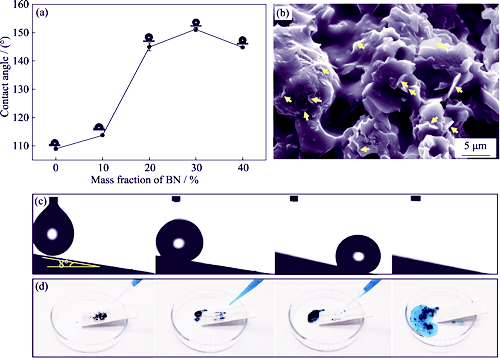
|
|
|
Adsorption Properties of Novel Bismuth-based SiOCNF Composite Membrane for Radioactive Gaseous Iodine
LIU Cheng, ZHAO Qian, MOU Zhiwei, LEI Jiehong, DUAN Tao
2022 Vol. 37 (10): 1043–1050
 Abstract
Abstract(
492 )
 HTML
HTML(
22)
 PDF
PDF(5554KB)(
631
)
Radioactive iodine is one of the typical nuclear fission products. As a result, adsorption-separation- solidification of radioactive iodine (129I, 131I, etc.) is important for nuclear power operations and spent fuel reprocessing. In this study, a novel type of bismuth-based composite nanofiber membrane (Bi@SiOCNF) was prepared by thermal reduction and electro-spinning technology using a kind of commercial poly-thylsilsesquioxane resin (MK resin) as raw material. Based on SiOC fiber, the bismuth metal was uniformly loaded on the surface of SiOCNF and in the three-dimensional network space, showing excellent capability for capturing and immobilizing gaseous iodine. According to the adsorption experiment results, the material can reach the maximum saturated adsorption capacity as high as 515.2 mg/g within 2 h. Adsorption mechanism of gaseous iodine on bismuth-based SiOCNF composite nanofiber membrane was through chemical adsorption and physical adsorption which was verified by XRD, XPS and other tests. Thermogravimetry analysis (TGA) demonstrated that the Bi@SiOCNF owned an excellent thermal stability. All above properties indicate that the material has potential applications in the capturing, fixation and storage of radioactive gaseous iodine in nuclear power plants and spent fuel reprocessing plants.
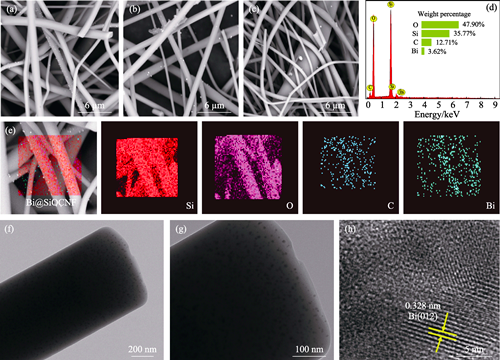
|
|
|
Fabrication of Hollow Fiber Supported TiO2 Ultrafiltration Membranes via Ultrasound-assisted Sol-Gel Method
LÜ Qingyang, ZHANG Yuting, GU Xuehong
2022 Vol. 37 (10): 1051–1057
 Abstract
Abstract(
349 )
 HTML
HTML(
23)
 PDF
PDF(3173KB)(
528
)
TiO2 membranes have been applied in ultrafiltration (UF) separation due to their strong hydrophilicity and good thermochemical stability, but most of them are tubular membranes with low permeation flux and time-consuming preparation. To improve the flux and save the preparation time of TiO2 membrane, hollow fiber supported TiO2 UF membranes were prepared via ultrasound-assisted Sol-Gel method by using tetrabutyl titanate as precursor. Effects of acid/titanium molar ratio, ultrasound time and calcination temperature on TiO2 sols and UF performance of membranes were investigated extensively. The results showed that when the acid/titanium ratio was 0.25, the obtained TiO2 sol showed an average particle size of 3252 nm, which would be reduced to 1817 nm after ultrasonic treatment for 30 s. Coating with the above TiO2 sol, defect-free TiO2 UF membrane with average thickness of 1 μm can be prepared on hollow fiber support by calcining at 350 ℃ twice. The pure water flux of the obtained membrane was 145 L·m-2·h-1·bar-1, and the dextran molecular weight at 90% rejection of membrane was 2586 Da with corresponding average pore size of 2.5 nm.
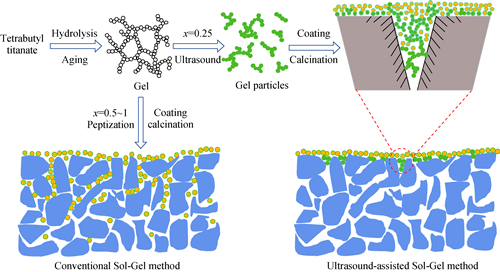
|
|
|
Heteroatom-doped Biochar for Direct Dehydrogenation of Propane to Propylene
GAN Hongyu, FENG Yan, YANG Dehong, TIAN Yubin, LI Yang, XING Tao, LI Zhi, ZHAO Xuebo, DAI Pengcheng
2022 Vol. 37 (10): 1058–1064
 Abstract
Abstract(
412 )
 HTML
HTML(
18)
 PDF
PDF(924KB)(
516
)
Carbon materials have been widely used in various catalytic reactions due to their excellent properties, such as low cost and good chemical/ thermal stability. In this study, nitrogen-doped, boron-doped, and boron-nitrogen co-doped biochars were prepared by in-situ gas-phase doping strategy using natural absorbent cotton as the raw materials. In the reaction of direct dehydrogenation of propane to propylene, the heteroatom-doped biochar showed higher propane conversion and propylene selectivity than the undoped biochar. It was also found that the catalytic performance of nitrogen and boron independently doped biochar was better than that of boron and nitrogen co-doped biochar. The nitrogen-doped biochar exhibited the best catalytic performance of which, at the reaction temperature of 600 ℃, the propane conversion reached 17.6%, and the olefins yield was 14.8%. After dehydrogenation reaction for 12 h, the catalyst’s performance exhibited no apparent declination. The characterization results revealed that nitrogen doping and boron doping in biochars could transform many C-O groups on the surface of biochar into C=O groups at an advantage of propane dehydrogenation activity, which inhibits the C-C bond breaking in the reaction process and improves the selectivity of propylene. Furthermore, duo to biochars rich in resources and low cost, they would promote the industrialization of direct dehydrogenation of propane.
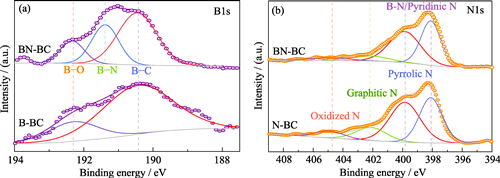
|
|
|
Mn-HAP SCR Catalyst: Preparation and Sulfur Resistance
CHEN Yaling, SHU Song, WANG Shaoxin, LI Jianjun
2022 Vol. 37 (10): 1065–1072
 Abstract
Abstract(
292 )
 HTML
HTML(
17)
 PDF
PDF(772KB)(
423
)
Low-temperature selective catalytic reduction (SCR) denitrification is an important technology for the end treatment of flue gas and enhancing sulfur resistance of catalysts is a challenge demanding prompt solution in the field of low-temperature SCR. Here, a Mn-HAP catalyst for nitrogen removal at low temperature (100-200 ℃) was successfully synthesized by co-precipitation method using hydroxyapatite (HAP) as carrier and Mn as an active component, and then its denitrification performance and resistance to fight against metal sulfate and ammonium sulfate poisoning were studied. The results showed that the sulfur resistance of the catalyst could be improved to a certain extent by using HAP as Mn active substance carrier. When the reaction temperature was 140 ℃, the denitrification efficiency of the SCR catalyst reached 100%. Meanwhile, the effect of metal sulfate on the denitrification activity at low temperature was more significant than that of ammonium sulfate, and the denitrification efficiency under the two sulfate species at 120 ℃ was reduced by 37.40% and 8.83%, respectively, as compared with that of fresh catalyst. Different characterization analysis indicated that different surface sulfur species could reduce the specific surface area and change the oxidation state of active Mn to various degrees. The main reason for catalysts deactivation is that the metal sulfate can significantly decrease the proportion and oxidation-reduction performance of Mn4+. Therefore, this study provides an important direction for improving the sulfur resistance of SCR catalysts.
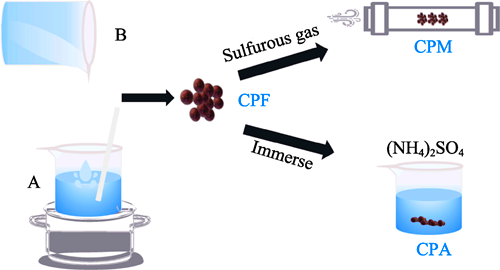
|
|
|
Structural Evolution and Chemical Durability of Thorium-incorporated Nd2Zr2O7 Pyrochlore at A and B Sites
WANG Lielin, XIE Hua, XIE Yuqi, HU Pingtao, YIN Wen, REN Xinyue, DING Yun
2022 Vol. 37 (10): 1073–1078
 Abstract
Abstract(
304 )
 HTML
HTML(
11)
 PDF
PDF(859KB)(
393
)
A2B2O7 pyrochlore is considered as a candidate host matrix for high-level radioactive wastes due to its incorporation and physicochemical stability. Nd1.8Th0.2Zr2O7 and Nd2Zr1.8Th0.2O7 pyrochlore samples doped with 20% thorium (in molar) were successfully prepared by using spray-pyrolysis and high temperature sintering method. The structures of the synthesized immobilization were characterized, and the chemical durability tests were investigated by the MCC-1 method. Structural analyses show that samples Nd1.8Th0.2Zr2O7 and Nd2Zr1.8Th0.2O7 exhibit pure single pyrochlore structure. Rietveld refinement analyses show that the value of 48f oxygen site parameter of 20% thorium-doped Nd2Zr2O7 pyrochlore increases, which suggests that the structure is transforming from ordered pyrochlore to disordered structure, as compared with Nd2Zr2O7. The Nd1.8Th0.2Zr2O7 pyrochlore structure evolution results from the distortion of the AO8 hexahedral structure, while the B-site substitution leads to partial deformation of the BO6 octahedron. The leaching experiment results show that the normalized leaching rate of thorium is as low as 10-5g·m-2·d-1 after 42 d. Thorium can be well incorporated at the A and B cation sites of the Nd2Zr2O7 pyrochlore structure of which the immobilization exhibits the excellent physical and chemical properties.

|
|
|
Effect of Te and In Co-doping on Thermoelectric Properties of Cu2SnSe3 Compounds
REN PeiAn, WANG Cong, ZI Peng, TAO Qirui, SU Xianli, TANG Xinfeng
2022 Vol. 37 (10): 1079–1086
 Abstract
Abstract(
357 )
 HTML
HTML(
12)
 PDF
PDF(1705KB)(
418
)
Recently, Cu2SnSe3-based compounds, as a new environment-friendly thermoelectric material, have attracted worldwide attentions. However, the pristine Cu2SnSe3 compound possesses relatively low carrier concentration and thus an inferior electronic transport properties. To optimize the thermoelectric properties of Cu2SnSe3- based compounds, herein, two series of Cu2SnSe3-xTex (x=0-0.2) and Cu2Sn1-yInySe2.9Te0.1 (y=0.005-0.03) samples were synthesized through traditional melting-annealing technique combined with plasma activated sintering (PAS). The role of Te and In co-doping on the thermoelectric properties of Cu2SnSe3-based compounds were systematically investigated. The solubility limit of Te in the Cu2SnSe3-xTex compounds is around 0.10. The substitution of Te on Se site significantly increases the effective mass of charge carrier from 0.2me for pristine Cu2SnSe3 compound to 0.45me for Cu2SnSe2.9Te0.1 compound, which improves the power factor of the material. Cu2SnSe2.99Te0.01 compound attains the maximum power factor of 1.37 μW·cm-1·K-2 at 300 K. To further improve the electronic transport properties of the material, Cu2SnSe2.9Te0.1 was chosen as the matrix and In was selected to dope on Sn site. We found that doping with In significantly improves the carrier concentration of Cu2SnSe3-based compounds from 5.96×1018 cm-3 for Cu2SnSe2.9Te0.1 to 2.06×1020 cm-3 for Cu2Sn0.975In0.025Se2.9Te0.1, which promotes the participation of multiple valence bands in the electronic transport. All these produce the great enhancements on the electrical conductivity, effective mass of charge carriers and power factor. As a result, Cu2Sn0.995In0.005Se2.9Te0.1 compound obtains the maximum power factor of 5.69 μW·cm-1·K-2 at 473 K. Due to the significant improvement of electrical transport performance and the decrease in lattice thermal conductivity, the maximum ZT of 0.4 is achieved for Cu2Sn0.985In0.025Se2.9Te0.1 compound at 773 K, which is 4 times higher than that of pristine Cu2SnSe3 compound.

|
|
|
Effect of Li2O Sintering Aid on Sintering Characteristics and Electrical Conductivity of LSGM Electrolyte for Solid Oxide Fuel Cell
FAN Shuai, JIN Tian, ZHANG Shanlin, LUO Xiaotao, LI Chengxin, LI Changjiu
2022 Vol. 37 (10): 1087–1092
 Abstract
Abstract(
302 )
 HTML
HTML(
15)
 PDF
PDF(747KB)(
463
)
This work investigated the influence of Li2O as a sintering aid on the sintering behavior of La0.8Sr0.2Ga0.8Mg0.2O3-δ (LSGM) electrolytes in solid oxide fuel cells, which systematically presented the effects of sintering aid content and sintering temperature on the density, microstructure, phase composition, and the ionic conductivity of sintered LSGM bulk. The results show that addition of Li2O sintering aid not only reduces the sintering temperature, but also eliminates the LaSrGa3O7 impurity phase in the sintered LSGM and suppresses the formation of MgO impurity phase which is easily generated during the conventional sintering process. Moreover, the addition of Li2O increases the ionic conductivity of sintered LSGM electrolytes. When 1% (molar percentage) Li2O is added, the LSGM bulk sintered at 1400 ℃ for 4 h reaches 99% of the theoretical density and presents a single perovskite stracture. When tested at 800 ℃, the ionic conductivity of the sintered bulk reaches 0.17 S/cm, which is 20% higher than that of the sample without sintering aid. All results demonstrate that adding an appropriate amount of Li2O as sintering aid is of great significance for the application of high ionic conductivity electrolyte in intermediate- temperature solid oxide fuel cells (IT-SOFCs).
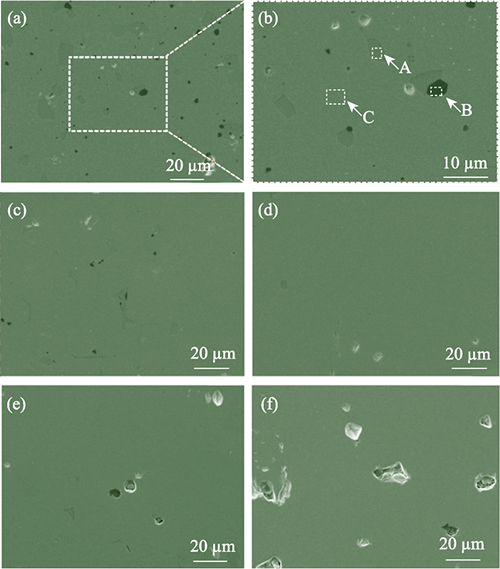
|
|
|
BiZnx/Si Photocathode: Preparation and CO2 Reduction Performance
LI Chengjin, XUE Yi, ZHOU Xiaoxia, CHEN Hangrong
2022 Vol. 37 (10): 1093–1101
 Abstract
Abstract(
463 )
 HTML
HTML(
28)
 PDF
PDF(11687KB)(
613
)
The conversion of CO2 into high value-added chemicals is an effective way to realize the carbon cycle, alleviate energy crisis and environmental problems. The preparation of metal-semiconductor electrodes provides a new idea for CO2 conversion by photoelectric coupling technology. In this study, Si was etched in alkali solution, on which a bimetallic Bi, Zn co-modified Si photoelectrocathode (BiZnx/Si) was prepared via the electrodeposition process, for the photoelectrochemical reduction CO2. The results show that the introduction of Bi and Zn can improve the light absorption performance, reduce the electrochemical impedance, and increase the electrochemical active surface area (ECSA). Especially, the ECSA of the best photoelectrocathode BiZn2/Si is 0.15 mF·cm-2. Besides, the cooperative effect of Bi and Zn can improve the adsorption performance toward the intermediates *OCHO. During the photoelectrochemical reduction of CO2, the Faradaic efficiency for HCOOH reaches up to 96.1% on the best photoelectrocathode BiZn2/Si at the potential of -0.8 V (vs. RHE). Moreover, the photocurrent intensity on the photoelectrocathode BiZn2/Si remained -13 mA·cm-2 during the 10 h photoelectric stability test, suggesting its high stability.
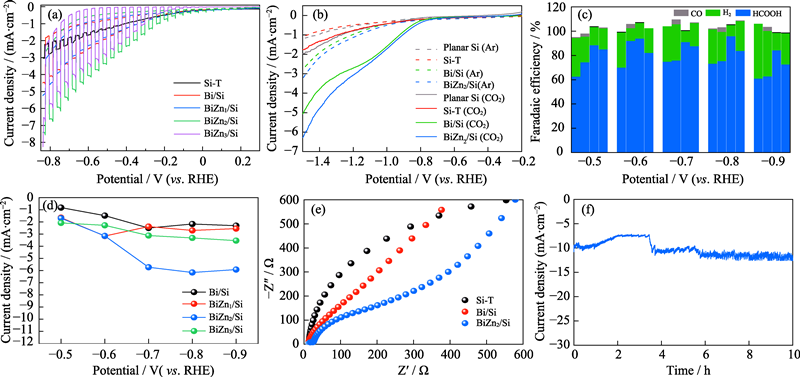
|
|
|
Synthesis of Orthorhombic Black Phosphorus by Chemical Vapor Transport Method
FU Mingfu, YANG Wen, LI Jiabao, DENG Shukang, ZHOU Qihang, FENG Xiaobo, YANG Peizhi
2022 Vol. 37 (10): 1102–1108
 Abstract
Abstract(
282 )
 HTML
HTML(
13)
 PDF
PDF(14643KB)(
461
)
Black phosphorus (BP) with excellent and unique physical and chemical properties has emerged as the most promising semiconductor for energy storage and conversion, micro-nano devices, photo- and electro-catalysis, biomedicine, and so on. It is crucial to synthesize high-quality precursors of orthorhombic BP for realizing the applications of two-dimensional BP and zero-dimensional BP quantum dots. Herein, the effects of mineralizer components and ratios on BP growth were studied by the chemical vapor transport (CVT) method without temperature gradient. The results indicate that orthorhombic BP can be synthesized under some experimental combinations that can be considered viable only when tin (or lead) and iodine coexist together with the appropriate ratio. And the mass ratio ranges of tin and iodine w(Sn/I2) for BP preparation is wide, and the size of BP crystal obtained at w(Sn/I2)=0.47 is up to 1.2 cm, of which yield and crystal quality are superior. Combined with the nucleation and growth mechanism of BP, tin and iodine are severely significant for the nucleation and growth of BP, which has been widely accepted. Mineralization effect of iodine is more obvious than that of tin, and sufficient tin contributes to the synthesis of large-size bulk BP crystals without temperature gradient. As a result, w(Sn/I2)=0.47 is the optimal minera lizer ratia for fabricating orthorhombic BP in this work.
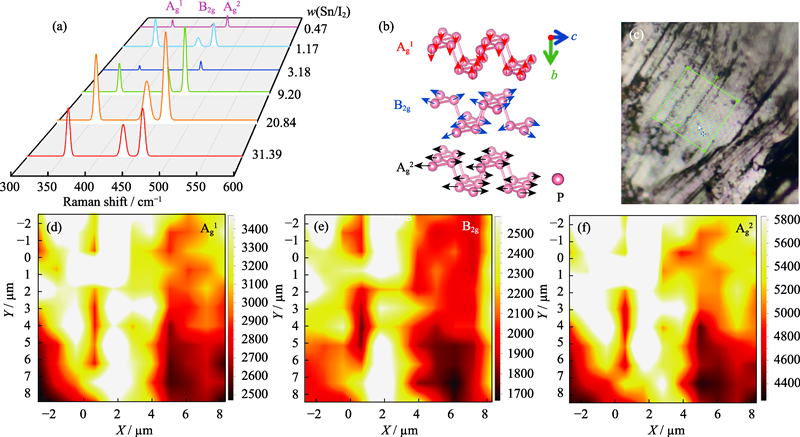
|
|
|
Preparation and Characterization of Ag2Se-based Ink Used for Inkjet Printing
ZHANG Keyi, ZHENG Qi, WANG Lianjun, JIANG Wan
2022 Vol. 37 (10): 1109–1115
 Abstract
Abstract(
360 )
 HTML
HTML(
17)
 PDF
PDF(2291KB)(
559
)
Preparation of silver selenide (Ag2Se) based thin films is significant to the micro devices. However, most of reported methods for preparing Ag2Se films have not achieved the accuracy control and flexible pattern design of films. Inkjet printing technology is believed to provide a valid approach to solve this problem by which combination Ag2Se and inkjet printing technology shows high value and importance. In this work, Ag2Se nanoparticles were synthesized by solvothermal method and then dispensed into different solvents to obtain the ink with high stability. Jetting parameters were further developed to achieve the jetting of Ag2Se ink and optimize the morphology of droplets. Ag2Se thin films were prepared on polyimide substrates via inkjet printing with different printing layers. As-printed films were finally annealed to increase the crystalline and density. The phase and surface morphology of Ag2Se films were characterized and the electrical conductivity of the films was measured by using four-probe measurement. Ag2Se films can achieve higher density and crystallinity with ink concentration and printing layers increasing, which leads to higher electrical conductivity. Improvement of structure and performance of Ag2Se films result from the increasing deposition and stacking density of Ag2Se nanoparticles. The electrical conductivity of inkjet-printed Ag2Se film can reach as high as 399 S·cm-1 at the ink concentration of 5 mg·mL-1 and the number of printing layers of 40, which provides a new orientation to prepare Ag2Se based films and devices.
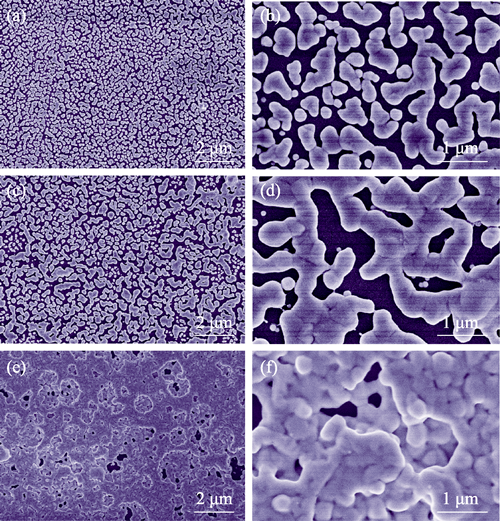
|
|
|
Preparation and Characterization of β-tricalcium Phosphate/Nano Clay Composite Scaffolds via Digital Light Processing Printing
ZHANG Hang, HAN Kunyuan, DONG Lanlan, LI Xiang
2022 Vol. 37 (10): 1116–1122
 Abstract
Abstract(
235 )
 HTML
HTML(
29)
 PDF
PDF(6579KB)(
405
)
β-tricalcium phosphate (β-TCP) has biodegradability and biocompatibility, but its inherent brittleness limits its application in load-bearing implants. In order to further improve the mechanical property and biocompatibility of β-TCP, β-TCP/NC (TNC) composite scaffold with nano clay (NC) as additive and the porous structure of the scaffold has a pore size of 200-300 μm was prepared by digital light processing (DLP) technique. When the content of NC is 10% (in mass), the sintering shrinkage of each structural feature of the support (TNC10) is the smallest. Addition of NC does not change the phase composition of TCP, and Si and Mg elements are evenly distributed on the surface of the scaffold. Addition of NC can improve the compression strength of TCP scaffolds. NC (particle size < 500 nm) is fused in the gap of TCP particles. Compared with pure TCP scaffolds, the compression strength of TNC10 is increased by 10%. In addition, the specific surface area of TNC10 group was more than 2 times higher than that of pure TCP. TNC degradation rate is faster while Ca2+, Mg2+, Si4+, and Li2+ can be continuously released, which maintains a weakly alkaline environment. The results demonstrate that the addition of NC has a certain promotion effect on the mechanical strength, degradation performance β-TCP scaffolds. Porous bioceramic scaffolds with good physical, chemical property by DLP method have great application prospects in the field of bone repair.

|
|
|
Mechanism of Mg-codoping in Improving the Time Performance of Gd3(Al,Ga)5O12:Ce Scintillator
LI Mingqing, WANG Linwei, DING Dongzhou, FENG He
2022 Vol. 37 (10): 1123–1128
 Abstract
Abstract(
296 )
 HTML
HTML(
20)
 PDF
PDF(1318KB)(
515
)
With its excellent comprehensive performance, Gd3(Al,Ga)5O12:Ce (GAGG:Ce) scintillation crystal has broad application prospects. To accelerate the luminescence decay rate, Mg-codoped Gd3(Al,Ga)5O12:Ce single crystals were grown by Czochralski method. The test results show that with the concentration of Mg2+ increasing, the scintillation decay of the crystal accelerates and the light output decreases. The conventional interpretation suggests that Mg2+ could convert part of Ce3+ into Ce4+ through charge compensation, and the Ce4+ luminesces more quickly. This study tries to discuss the mechanism of Mg-codoping in GAGG:Ce crystals from the perspective of antisite defect. Since the ionic radius of Ce is larger than Gd, the doping of Ce ions leads to a distortion of the crystal lattice near the luminescence center CeGd. As a result of the distortion, the space of the adjacent octahedral sites become larger, and the antisite defects are more likely to form in these larger octahedral sites. Eventually each luminescence center CeGd is surrounded by four antisite defects GdAl, which would capture carriers and delay the energy transfer from the matrix to the luminescence center. As the ionic radius of Mg is between Gd and Al, MgAl also prefers to form in those distorted octahedral sites, which inhibits the formation (or enrichment) of the antisite defect GdAl near the luminescence center CeGd, and eventually reduces (or even eliminates) the adverse effects of the antisite defect on the luminescence center. XEL results show that with the increase of Mg concentration, the emission peak related to the antisite defect becomes weaker, which indicates that Mg could inhibit the formation of the antisite defect.
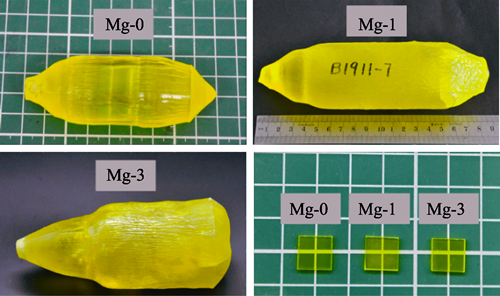
|
|
|
Centimeter-sized Cs3Cu2I5 Single Crystal: Synthesized by Low-cost Solution Method and Optical and Scintillation Properties
XU Tingting, LI Yunyun, WANG Qian, WANG Jingkang, REN Guohao, SUN Dazhi, WU Yuntao
2022 Vol. 37 (10): 1129–1134
 Abstract
Abstract(
724 )
 HTML
HTML(
35)
 PDF
PDF(4508KB)(
812
)
In recent years, low-dimensional metal halide perovskites/quasi-perovskites with high photoluminescence quantum yield have shown potential application prospects in nuclear radiation detection. In this paper, centimeter- sized zero-dimensional perovskite Cs3Cu2I5 single crystals with high optical quality was grown by the anti solvent diffusion method. The optical absorption, transmittance photoluminescence excitation (PLE) and emission (PL), time-resolved photoluminescence, X-ray excited radioluminescence (XEL), afterglow, thermoluminescence (TL) and γ-ray detection performance of Cs3Cu2I5 single crystals were comprehensively investigated. The optical bandgap of as-prepared Cs3Cu2I5 single crystals is 3.68 eV. Under the excitation of X-ray, Cs3Cu2I5 single crystals show blue emission peaking at 448 nm originated from self-trapped exciton emission, and the principal scintillation decay time is 947 ns (96%). The afterglow level of Cs3Cu2I5 single crystals is comparable to that of commercial BGO crystal. In addition, Cs3Cu2I5 single crystals exhibit a high light yield of 29000 photons/MeV as γ-ray scintillators, and their scintillation properties are comparable to that of Cs3Cu2I5 single crystals prepared by the melt growth method. Therefore, this work demonstrates the feasibility of low-cost crystal growth of high-performance Cs3Cu2I5 single crystals.
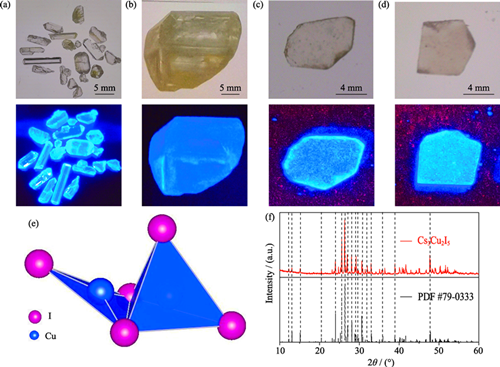
|
|
|
MoS2 with Different Morphologies: Preparation and Gas-sensing Property of NH3
LI Wenbo, QIAN Rong, ZHUO Shangjun, JIANG Hong, SHENG Cheng, ZHU Yueqin
2022 Vol. 37 (10): 1135–1140
 Abstract
Abstract(
400 )
 HTML
HTML(
10)
 PDF
PDF(1097KB)(
611
)
Ammonia leak is one of the key factors for air pollution, which may cause acute edema, respiratory failure and other diseases harmful to human health. Nowadays, the development of high-performance ammonia sensors has become one of the important means of real-time monitoring and safety warning of ammonia. In this work, three types of molybdenum disulfide with different morphologies of nanoflower, nanosphere and nanosheet were prepared by the hydrothermal method, and three types of MoS2 ammonia sensors were constructed. The results of gas-sensing experiments showed that among these MoS2 ammonia sensors with different morphologies, the NH3 gas sensor made of nanoflowers MoS2 performed the best performance with a high response value of 7.41% to 10×10-6 NH3, while those of the nanosheets MoS2 and nanospheres MoS2 sensors under the same NH3 concentration were 2.01% and 5.11%, respectively. In addition, the nanoflowers MoS2 sensor also exhibited excellent repeatability, stability and selectivity. The reason for the superior response performance of the nanoflower MoS2 ammonia sensor is mainly due to the larger surface area, which could provide more active sites for the adsorption of ammonia. This study demonstrates an effective way to prepare high-performance NH3 sensors with using MoS2 as the substrate material.
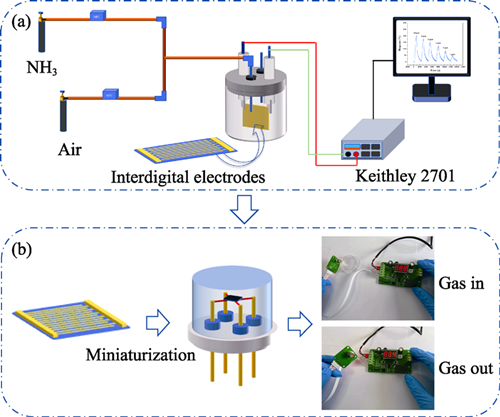
|
|
|
NiN4/Cr Embedded Graphene for Electrochemical Nitrogen Fixation
WU Jing, YU Libing, LIU Shuaishuai, HUANG Qiuyan, JIANG Shanshan, ANTON Matveev, WANG Lianli, SONG Erhong, XIAO Beibei
2022 Vol. 37 (10): 1141–1148
 Abstract
Abstract(
329 )
 HTML
HTML(
33)
 PDF
PDF(2989KB)(
497
)
Owing to the heavy energy consumption and the massive CO2 emission during ammonia synthesis via Haber-Bosch process, a clean technology of nitrogen reduction electrocatalysis under ambient conditions is of significance for the sustainable energy conversion progress in future. In the study, the nitrogen reduction reaction of TM1N4/TM2 embedded graphene is comprehensively investigated using density functional theory calculations. Fully considering the activity and stability, our results reveal that NiN4/Cr anchored graphene exhibits the best catalytic activity via the enzymatic reaction pathway wherein the potential determining step is located at the first hydrogenation with an onset potential of 0.57 V, being superior to the commercial Ru-based material. Furthermore, compared with the isolated Cr atom decorated nitrogen functionalized graphene, the introduction of NiN4 moiety decreases ΔGmax and enhances the electrocatalytic performance. According to the Mulliken charge analysis, the physical origin of the catalytic activity is ascribed to the electron transition between the supports and reaction intermediates. Overall, these results pave a way for the design of the high efficient electrode material for ammonia synthesis and provide a fundamental insight into the electrocatalysis.
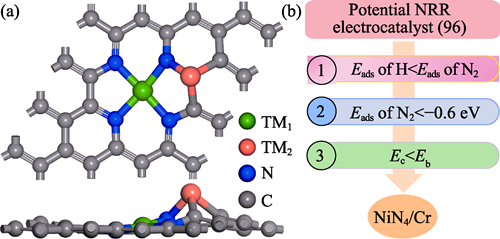
|
|